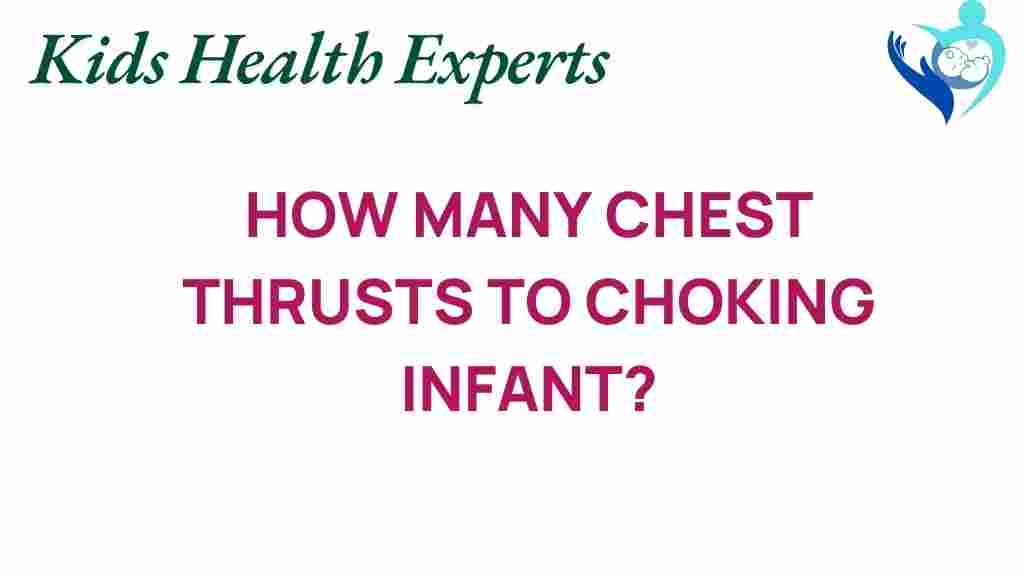How Many Chest Thrusts Are Necessary for a Choking Infant?
When it comes to infant safety, knowing how to respond to a choking infant is crucial. Choking is a leading cause of injury and death among young children, and being prepared can save a life. This article will explore the appropriate number of chest thrusts necessary for a choking infant, emphasizing the importance of first aid, emergency response, and proper pediatric care.
Understanding Choking in Infants
Choking occurs when an object obstructs the airway, preventing an infant from breathing. Common causes include:
- Small toys
- Food items (e.g., grapes, nuts)
- Pieces of hard candy
- Coins
Recognizing the signs of a choking infant is essential. Symptoms may include:
- Inability to cry or make sounds
- Gasping or wheezing
- Turning blue or pale
- Clutching the throat
First Aid Steps for a Choking Infant
When faced with a choking infant, quick and effective action is vital. The recommended first aid procedure involves a combination of back blows and chest thrusts. Here’s a step-by-step guide on how to perform chest thrusts on a choking infant:
Step 1: Assess the Situation
Before taking action, assess whether the infant is truly choking:
- Is the infant unable to cry, breathe, or cough?
- Is there a visible obstruction?
If the infant can cough or make sounds, encourage them to continue coughing to expel the object.
Step 2: Position the Infant
If the infant is unable to breathe or is turning blue, it’s time to act. Place the infant face down on your forearm, supporting their head and neck. Ensure that the infant’s head is lower than their chest.
Step 3: Administer Back Blows
Use the heel of your hand to deliver up to five firm blows between the infant’s shoulder blades. This can help dislodge the object causing the choking.
Step 4: Perform Chest Thrusts
If back blows are ineffective, you will need to perform chest thrusts. Here’s how:
- Turn the infant onto their back, keeping their head lower than the chest.
- Place two fingers in the center of the infant’s chest, just below the nipple line.
- Deliver quick, thrusting motions inward and upward. Aim for about five chest thrusts.
Step 5: Continue the Cycle
If the object is still not dislodged, alternate between back blows and chest thrusts until the infant can breathe or emergency help arrives. Remember, the cycle should consist of:
- Five back blows
- Followed by five chest thrusts
Continue this sequence until help arrives or the infant can breathe again.
When to Call for Help
If the infant remains unresponsive or if you are unable to dislodge the object after several cycles of back blows and chest thrusts, call emergency services immediately. It’s crucial to get professional help as soon as possible.
Pediatric Care and Health Guidelines
Understanding the guidelines for pediatric care can significantly enhance the safety of infants. It’s essential for caregivers and parents to learn proper rescue techniques and stay updated on health guidelines. Here are some tips:
- Attend first aid training courses focused on infant care.
- Keep emergency numbers handy.
- Stay calm in emergencies; your composure can help reassure the infant.
Troubleshooting Tips
In the event of a choking incident, you may encounter various challenges. Here are some troubleshooting tips:
- Difficulty in positioning: If you are struggling to hold the infant correctly, find a flat surface to lay them down safely.
- Inadequate force: Make sure your thrusts are firm enough to create the necessary pressure to dislodge the object.
- Infant becomes unconscious: If the infant becomes unresponsive, begin CPR immediately and call for emergency help.
Conclusion
Knowing how many chest thrusts are necessary for a choking infant can be the difference between life and death. Following the proper first aid steps—back blows followed by chest thrusts—ensures that you are prepared for such emergencies. Always prioritize infant safety and stay informed about the latest health guidelines. Consider taking a first aid class to boost your confidence and ability to respond effectively.
For further information, consider visiting the American Academy of Pediatrics website for comprehensive resources on pediatric care.
Remember, in any emergency involving a choking infant, your prompt action and knowledge can save a life.
This article is in the category Care and created by KidsHealthExperts Team
